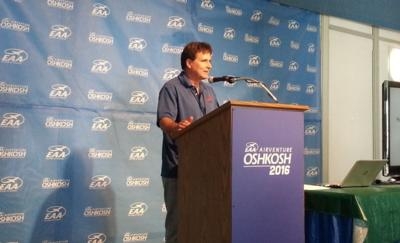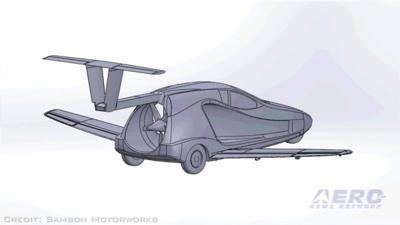Moving Towards A Flyable Prototype, The Flying Sports Car Reaches New Milestones
By Anthony Liberatore
In what they believe is a first in the Experimental Aircraft Category, Samson has engineered and tested a Fly-By-Wire (FBW) rudder system that is retractable when the Switchblade roadable aircraft is in its driving configuration.

In a news conference at AirVenture, Samson Switchblade CEO and Founder Sam Bousefield (pictured) announced a number of milestones as the Switchblade flying sports-car progresses towards a pre-production prototype.
The genesis of applying the FBW system occurred while members of the Switchblade engineering team were wrestling with the traditional mechanical rudder linkage with the retractable tail assembly as Bousefield noted in looking for the best solution the team went into “Let's solve this thing” mode. And solve it they did, by leveraging throttle by wire technology developed for engine controls in non aviation applications. The benefits of this leverage and Samson's engineering culminated in a rudder control system that has redundant electrical actuators (2), redundant pilot input devices (2) and redundant power and battery backup systems (2 each ).
In a discussion with ANN, Bousefield elaborated on some of the technical aspects of this intriguing vehicle. On the road-worthy side, the Switchblade uses a Continuous Variable Transmission (CVT) that is not of the traditional belt type found on recreational vehicles. What it has is the most robust transmission system Bousefield could find, and is of a “ball type” CVT design derived from the oil industry. In discussing the aerodynamics of the Switchblade, Bousefield noted the current retractable tail configuration has 2.5X the effectiveness in its current location vs. if it had been placed closer to the aft end of the fuselage and operating in it's wake.

Bousefield also noted that during one stage of development, a fuel tank size expansion design change near the side inlets to the ducted propeller area actually ended up reducing the Switchblade's drag. Bousefield said a great deal was learned in the Switchblade's development program from the R/C models used to prove out it's aerodynamics. When asked about "duct vs no-duct", Bousefield said in his opinion there is a sweet spot for them, which was confirmed by Chief Engineer Robert Bulaga of Trek Aerospace.
ANN asked Bousefield about the creative process in developing a vehicle that is both an auto and an aircraft, and did he look at the work of those before him that designed and built such vehicles. His response was yes, but their journey wasn't so much as what they did right or wrong, but their timing (i.e. market acceptance). He also noted he looked their work from the perspective as too what were their problems that were not solved, and what was needed to solve them.
He then noted in regards to Switchblades design, what is feasible in terms of package and roadability of the vehicle with all it's aero-devices stowed and moving safely with it. In terms of safety Bousefield noted one of the design challenges is what is the normal engagement mode (and where to engage within the respective drivetrains) of the propeller going down the road and the engagement mode of the wheels upon landing. His answer was thoughtful and detailed and was a marvelous insight into the inventors thought process and his passion for the Switchblade.
(Staff images)
 ANN's Daily Aero-Linx (05.02.24)
ANN's Daily Aero-Linx (05.02.24) ANN's Daily Aero-Term (05.02.24): Touchdown Zone Lighting
ANN's Daily Aero-Term (05.02.24): Touchdown Zone Lighting Aero-News: Quote of the Day (05.02.24)
Aero-News: Quote of the Day (05.02.24) ANN FAQ: Contributing To Aero-TV
ANN FAQ: Contributing To Aero-TV NTSB Final Report: Cirrus Design Corp SR20
NTSB Final Report: Cirrus Design Corp SR20




